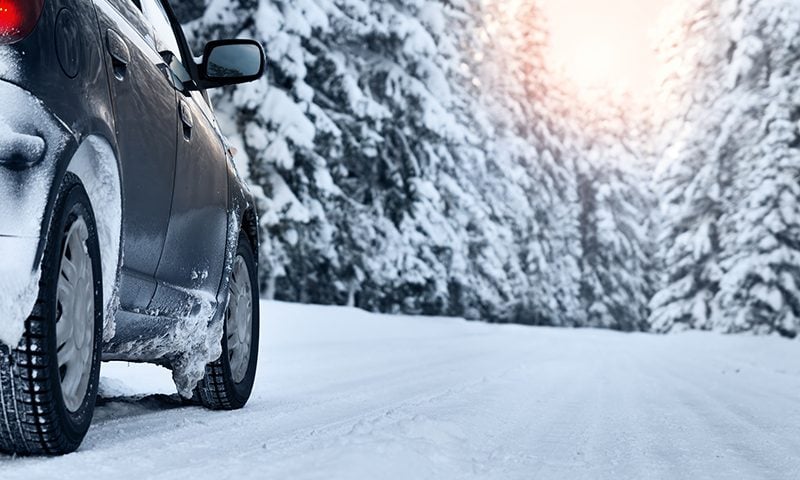Driving in winter: The complete guide

Yes, it’s that time of year again — winter is here. And while you’ll be wanting nothing more than to snuggle up on the sofa with a hot cup of cocoa, you’ll still have to get behind the wheel sometimes.
Whenever you head out on the roads this winter, make sure that both you and your car are prepared for driving in winter conditions.
Top 10 tips for driving in winter
Carry out quick car checks
To help avoid an unwanted breakdown on cold, dark and wintry roads, carry out some simple car checks before the worst of the weather hits.
Your car should always be well maintained, but it’s extra important in winter to make sure all your lights are fully functional, oil is topped up, coolant levels are balanced and your tyre treads are ready for the extra challenging conditions winter can bring.
Prepare for the worst
When driving in winter conditions, it’s always worth preparing for the worst, which is why a winter driving kit for emergencies is a must-have when the weather turns.
This should include useful things such as a (wind-up) torch, blanket, first-aid kit, a spade for digging out of mud or snow, a warning triangle and high-visibility vest.
Include a back-up portable charger for your phone and some snack bars and water just in case the worst should happen.
Drive according to the conditions
It might sound obvious but driving safely is probably the best thing to do in awful weather; whether it’s snowy, icy, windy or wet out there.
Your reaction times will likely be slower because of the weather, so drive slowly to give yourself a better chance of reacting to anything on the road ahead.
Remember to take corners carefully, as well as any other spots where your vision might be obscured, and don’t brake or accelerate too hard as this can lead to skidding on slippery roads.
Leave some space
In perfect conditions, experts recommend leaving a two-second gap to the vehicle ahead, but in adverse weather you need to leave longer than this.
If it’s icy or wet, keep a good-sized gap between you and the next car, as you’ll need all the space you can get to brake in these conditions.
Stopping distances are twice as long when it’s wet, and when it’s icy this can rise to 10 times the normal distance.
Stay focused
If the weather outside is frightful, then keep your eyes peeled for potential hazards (think gritter lorries or obstacles hidden by snow) and other road users.
Driving slowly will help you out with this. As the festive period hits, also be aware that there could be a worrying amount of fatigued and illegally well-lubricated drivers on the roads, so stay vigilant at all times.
Use your lights
Your lights are your best friends in terrible weather, so when you’re carrying out those simple car checks, make sure you check all the lights on your car.
If you encounter fog, keep your front and back fog lights on, and remember to turn them off when the visibility’s better so you don’t blind other drivers.
If you’re driving a new car and don’t know how to switch your fog lights off, then check your user manual before setting off!
Check the forecasts
Know what to expect on the roads by checking the weather forecast before you head out the door.
Whether online, in-app or on TV, weather forecasts can mean you don’t get caught out by an unexpected blizzard or thick fog, so you can plan your journey accordingly.
Make sure your car is clear
If you wake up to an icy windscreen, don’t just clear enough ice so you can see out of it.
This is called portholing and it’s illegal, so you could be slapped with a fine if caught.
Clear all your windows entirely, and if there’s any fresh snow on the roof of your car, then clear that too.
If snow falls off your roof when driving, it can be a hazard for other road users and can also get you in trouble with the police as it’s also illegal.
Try not to skid
One of the many perils of driving in winter is icy roads, but there are a few ways to stop your car from losing control.
Use the highest gear you can but keep your speed slow to encourage your tyres to grip the road.
Brake more gently than usual to stop the wheels from locking, and if you’re skidding, stay off the brakes and just gently ease up on the accelerator.
Steering into the skid until your car tyres grip again is also advised.
If water’s the problem, avoid aquaplaning by driving slowly in a lower gear until you’re back on dry land.
Stay at home
The most sensible way to stay safe on the roads when the weather gets bad is to avoid driving altogether.
Sometimes, this will mean simply staying at home. But if you have to travel then check local public transport timetables and leave the car at home.
If you absolutely have to drive, then give yourself plenty of time to get to your destination safely and soundly.
Before you’re officially ready for driving in wintry conditions it’s worth having a quick read over our guide to dealing with a breakdown in winter, fingers crossed you won’t need to put any of it into practice, but it’s better to be prepared just in case.


